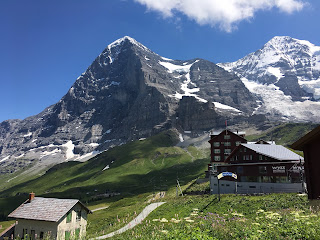Hemingway's observation:
Switzerland is a small steep country, much more up and down than sideways, and is all stuck over with large brown hotels built on the cuckoo clock style of architecture.Precisely. Everywhere there are Chalets, but they'd look funnily out of place if not for the ever-present mountains.
Chalets at Mürren: Cuckoo, Cuckoo (left, author; right, McDade)
If you range into cities like Zurich or Luzern, off in the distance -- slight or far -- you see snowy mountains. Unlike the wide spread of Rocky Mountains in the US, Switzerland's mountains are much closer together. In consequence, much of Switzerland is made up of toweringly steep way-ups that squeeze against the narrow, dizzyingly-down valleys; it's a paradise for those who live exist in a sideways land.
These geographical physics (up/down vs sideways) help to explain Iowa's new motto: "Welcome to Iowa. We hope you brought something to do."
One Consequence of Sideways
So. You must get out of sideways land and go to one that's up and down -- and do so regularly. You go, for instance, to Switzerland where there are things to do. Switzerland's famous mountains (you can read about them anywhere) -- have a truth about them: they are dangerous and have claimed many lives -- 500 on the Matterhorn since it was first ascended. There are consequences to up and down. The stories (as in the classic book The White Spider, about the Eiger) will make your palms sweaty with vertical edginess. Yet what do you gain with such exposure?
Clouds and Cliffs along the Hornli Ridge (source: video capture, author)
You gain something inestimable. With the exposure comes the views of massive spaces of still air between the rock faces and glaciers, space often punctuated with the dimly heard clunking and tinkling of cow bells tweedling up from the valley 2000 feet below. You will also meet cows high in the mountains where they feed on the steep and slanting carpets of grass and flowers. You can read about it. But it's not the same. You have to go there.
The Hollow North Face of the Eiger (left) next to the
Snowier Mönch with the Eiger Glacier between them;
viewed from Kleine Scheidegg (source: author)
Snowier Mönch with the Eiger Glacier between them;
viewed from Kleine Scheidegg (source: author)
And the thing about a mountain here (not least the Matterhorn) -- it matters. Even when it's encased in cloud. It feels like a home for which you've longed but have never been to -- well worth all the huffing and puffing required to get there.
What else is here? Consider how sensible the Swiss are! Well, with everyone's money in their banks, they'd best be fairly sensible. But they also market their own goods smartly: Victorinox everywhere, with their diverse products. The workers in the mountains -- whether on their fabulously designed high railways or gondolas -- all wear Switzerland's own Mammut vests and jackets. Of course, there are Swiss watches, not just in the train stations. Everywhere. And their foods -- not merely the diverse sausages, prosciutto (including lamb), myriad cheeses, and breads -- are all brilliant. And then the Swiss engineering in a million other products, including their gondolas and ski lifts -- that even turn corners. Amazing.
So too: the cows sport Swiss-made bells of various sizes, as do the domestic goats (not the wild Ibex peering down at you from ledges 800 feet above as you hike past). Every little move a cow makes sets the bell ringing. It might be very jolly -- it sounds so and, apparently, the animals are jolly wearing them. But if it were around our own necks we'd be A) deaf ("What?.... What?") and B) distracted at every turn.
And yet, pop into a hardware store in Zermatt, for instance, and you will find the usual farming supplies, bolts, nuts, wrenches/spanners -- everything a hardware store in a rural area offers, but also -- bells. Huge, big, middling, and small: bells. Swiss made, which means not just simply well made but brilliantly so. What other country boasts such a thing? And there they are in a window, all lined up for the keepers of cattle.
Klinkle-Klunk: a Swiss-made Firmann Bell
And some of the older Chalets that no longer house cattle-keepers, like this below, sport the old bells. The shaped and soldered sheet-metal bells are for summer grazing; the round, cast bells are for when the cattle come down in the fall. Why? I don't know: an inn keeper told me this.
A Chalet in Mürren Sporting Its Old Bells (source: author)
It's a magnificent country that whispers into your Imagination, just as the Romantics told us it would.
Lauterbrunnen (Source: myswitzerland)
And if you are a Votary of the Blue Flower, it's the only place to go. Just ask Heinrich von Ofterdingen [Link].
In the Swiss Alpine Tundra (source: author)










No comments:
Post a Comment